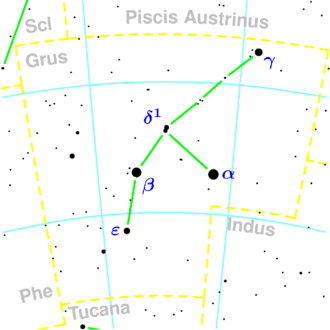NGC 7582
| Galaxy NGC 7582 |
|
|---|---|

|
|
| Photo from the Hubble Space Telescope | |
| AladinLite | |
| Constellation | crane |
|
Position equinox : J2000.0 , epoch : J2000.0 |
|
| Right ascension | 23 h 18 m 23.5 s |
| declination | -42 ° 22 ′ 14 ″ |
| Appearance | |
| Morphological type | (R'_1) SB (s) from Sy2 |
| Brightness (visual) | 10.5 mag |
| Brightness (B-band) | 11.3 mag |
| Angular expansion | 5.0 ′ × 2.3 ′ |
| Position angle | 157 ° |
| Surface brightness | 13.0 mag / arcmin² |
| Physical data | |
| Affiliation | Grus Quartet |
| Redshift | (5254 ± 23) · 10 −6 |
| Radial velocity | 1575 ± 7 km / s |
|
Stroke distance v rad / H 0 |
(69 ± 5) · 10 6 ly (21.3 ± 1.5) Mpc |
| diameter | 100,000 ly |
| history | |
| discovery | James Dunlop |
| Discovery date | July 7, 1826 |
| Catalog names | |
| NGC 7582 • PGC 71001 • ESO 291-16 • MCG -07-47-029 • IRAS 23156-4238 • 2MASX J23182362-4222140 • SGC 231538-4238.6 • GC 4927 • h 3978 • AM 2315-423 • Dun 476 | |
NGC 7582 is a barred spiral galaxy of the Hubble type (R ') SB (s) ab in the constellation Crane in the southern sky . It is about 69 million light years away from the Milky Way and has a diameter of about 100,000 light years . The galaxy is classified as a Seyfert 2 galaxy , a special type of very bright galaxies that belong to the group of active galaxy nuclei (AGN).
Together with NGC 7552 , NGC 7590 and NGC 7599 , it forms the Grus Quartet.
The object was discovered by James Dunlop on July 7, 1826 .
The galaxy NGC 7582 imaged by GALEX
Web links
Commons : NGC 7582 - collection of images, videos, and audio files

